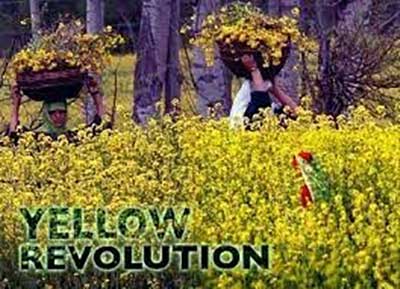Relevance: GS-3: Agricultural Resources, Food Security, Cropping Patterns.
Key phrases: yellow revolution, mustard, Oilseed, area, rain fed, irrigated area, Yellow rust.
Why in News?
- A new yellow revolution has finally taken off, as farmers expand the area under the crop by a quarter, conjuring up visions of endless mustard fields — a popular Bollywood staple.
What is Yellow Revolution?
- The revolution launched in 1986- 1987 to increase the production of edible oil, especially mustard and sesame seeds to achieve self-reliance is known as the Yellow Revolution.
- Sam Pitroda is known as the father of the Yellow Revolution in India. Yellow Revolution targets nine oilseeds that are groundnut, mustard, soybean, safflower, sesame, sunflower, niger, linseed, and castor.
Features of the Yellow Revolution
- The yellow revolution included incentives to farmers who were also provided processing facilities that included irrigation, fertilizers, pesticides, etc. transportation facility, minimum support price, warehousing, etc.
- Under the revolution, many boards such as the National Dairy Board were entrusted with responsibilities to promote oilseed production. The NDB has the responsibility to increase groundnut oil production in Gujarat.
- Similarly, the National Oilseeds and Vegetable Oils Development Board were responsible for the production enhancement of oilseeds in non-traditional areas.
- Oilseeds Production Thrust was established to popularize the four major oilseeds that are mustard, groundnut, soybean, and sunflower.
- Also, there were about 3000 oilseed societies established with 13 lakh farmers and 25 hectares of cultivable land in a different state of the country.
Present Status of Oilseed Crops in India:
- India accounts for about 15-20 per cent of global oilseeds area, 6-7 per cent of vegetable oils production, and 9-10 per cent of the total edible oils consumption. In terms of acreage, production and economic value, oilseeds are second only to food grains.
- As per the fourth advance estimates for 2018-19, the area and production of nine oilseed crops is 25.5 million hectare (Mha) and 32.26 million tonnes (MT), respectively. It shows an increase of 1.04 per cent in production, compared to 2008-09.
- Figure 1 is indicating trends in area, production and productivity of oilseeds since 1970. In India, majority of the oilseeds are cultivated under rain fed ecosystem (70%). Only 28% of oilseeds area is covered under irrigation.
- The area under oilseeds has experienced a deceleration in general, due to their relative lower profitability against competing crops like maize, cotton, chickpea, etc., under the prevailing crop growing and marketing situations.

- The area and production of oilseeds is concentrated in the Central and Southern parts of India, mainly in the states of Madhya Pradesh (27.89%), Rajasthan (21.49%), Maharashtra (14.84%), Gujarat, Andhra Pradesh and Karnataka.
- Acc. to the latest sowing data, acreage under mustard (including toria and taramira) has expanded by 24 per cent to a record 90.45 lakh hectares (lh), exceeding even the government-set target.
- The area under mustard alone has touched 84.76 lh (up 24.9 per cent). Before the start of the 2021-22 rabi season sowing, the government targeted increasing the output to 122.4 lakh tonnes (lt) from 75.8 lh. The production was 101.12 lt in 2020-21.
- “Even if the average yield is 1.5 tonnes per hectare, production will be 135 lt from the latest sowing areas. The yield was 1.51 tonnes per ha in 2018-19 and fell to 1.36 tonnes per ha the following year.

Challenges to oilseed production in India:
- In the current situation or period it's very difficult to expand the cultivation area. Because of which there is a shortage in edible oil.
- It is difficult to increase production of oilseeds because there are several constraints with these crops. Ex. lack of awareness and change in cropping pattern leading to significant decrease in area under oilseeds production.
- Production also decreases because oilseeds are more prone to pests and disease. Ex. white rust” pests
- Because of the unhealthy environment, unhealthy crops are being produced which leads to decrease in production of oilseeds.
Way forward:
- Yellow Revolution 1.0 improved productivity but could not help in increasing oilseeds production.
- Technology mission on oilseeds II and Yellow Revolution 2.0 with better planning can help India to achieve self-sufficiency in oilseeds and also increase India’s agri-export.
- Yield gap analysis shows that India’s oilseeds production can improve by reducing yield gap among states itself. There is a great scope for increasing the yields of oilseed crops. Better extension systems, with downward accountability with the last mile extension gaps plugged will increase productivity.
- The strategies for enhancing the productivity (and profitability) of oilseeds as under:
- Increasing seed production and distribution of newly released varieties.
- Low cost technologies with high impact on productivity will result in higher income which will encourage farmers to go for oilseeds farming.
- Strategies with emphasis on quality improvement and value addition leveraging technologies with a bearing on the employment through skill/ entrepreneurship development.
Source: The Hindu BL
Mains Question:
Q. Recent increase in the area under mustard cultivation could release India’s dependence on edible oil imports. So discuss the relevance of yellow revolution in India agriculture sector. What are the measures needed to boost oilseed cultivation in India?









